|
|
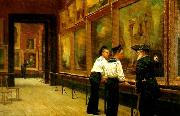 |
edward r taylor
|
|
Edward Richard Taylor RBSA (June 14, 1838 - January 11, 1911) was an English artist and educator. He painted in both oils and watercolours.
Taylor taught at the Lincoln School of Art and became influential in the Arts and Crafts movement as the first headmaster at the Birmingham Municipal School of Arts and Crafts from 1877-1903.
In December 1898, he founded Ruskin Pottery at Smethwick, Staffordshire. His son William Howson Taylor (1876 -1935) took over Ruskin Pottery after the death of his father. |
|
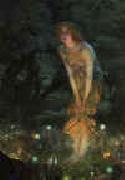 |
Edward Robert Hughes
|
|
British
1851-1917
Edward Robert Hughes (1851-1917) is a well known English painter who worked in a style influenced by Pre-Raphaelitism and Aestheticism. Some of his best known works are Midsummer Eve and Night With Her Train of Stars. Hughes was the nephew of Arthur Hughes. He often used watercolour/gouache. He was elected ARWS in 1891 and chose as his diploma work for election to full membership a mystical piece inspired by a verse by Christina Rossetti's "Amor Mundi". Technically Hughes experimented with ambitious techniques. He was a perfectionist who did numerous studies which in their own right turned out to be good enough for exhibition
He was also an assistant to the elderly William Holman Hunt. He helped the increasingly infirm Hunt with the version of The Light of the World now in St. Paul's Cathedral and with The Lady of Shalott. He died on April 23 1914 at his cottage in St. Albans, Hertfordshire.
|
|
|
|
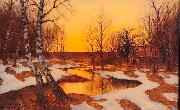 |
Edward Rosenberg
|
|
painted Solnedgang i vinterlandskap in 1921
Edward Rosenberg (1858-1934)Aliases: Axel Edvard John Rosenberg; Axel Edward John Rosenberg; Edvard RosenbergProfessions: Landscape painter. |
|
|
|
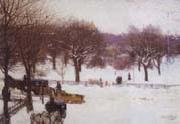 |
Edward Simmons
|
|
October 27, 1852 ?C November 17, 1931,was an American Impressionist painter, remembered for his mural work. He was born in Concord, Massachusetts, the son of a Unitarian minister. He graduated from Harvard College in 1874, and was a pupil of Lefebvre and Boulanger in Paris, where he took a gold medal. In 1894, Simmons was awarded the first commission of the Municipal Art Society, a series of murals ?? ??Justice,?? ??The Fates?? and ??The Rights of Man?? for the interior of the Criminal Courthouse at 100 Centre Street in Manhattan. This court is the criminal branch of New York Supreme Court where many New Yorkers serve on Jury Duty. Later Simmons decorated the Waldorf-Astoria hotel in New York, the Library of Congress, Washington, D.C., and the Capitol at Saint Paul, Minnesota. In the year 1914 he travelled with Childe Hassam to view the Arizona desert paintings of the rising California artist, Xavier Martinez at his Piedmont studio. Simmons was a member of the Ten American Painters, who, as a group, seceded from the Society of American Artists. He was also considered a contributor to the style known as the American Renaissance, a movement after the American Civil War that stressed the relationship of architecture, painting, sculpture and interior design. |
|
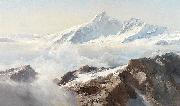 |
Edward Theodore Compton
|
|
(July 29 1849 - March 22 1921) was an English-born, German artist, illustrator and mountain climber. He is well-known for his paintings and drawings of alpine scenery, and as a mountaineer made 300 major ascents including no fewer than 27 first ascents.
Compton was born in Stoke Newington in London, the son of Theodore Compton, an art-loving insurance agent, and grew up in a deeply religious Quaker household. He attended various art schools, including, for a time, the Royal Academy in London, but otherwise he was mainly self-taught in art.
|
|
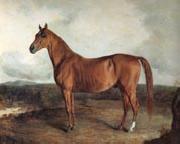 |
Edward Troye
|
|
American Artist .
b.1808 d.1874
American painter of Swiss birth. Before 1822, his father, Jean-Baptiste de Troy, a sculptor of minor fame, moved his family to England, where Edward was instructed in drawing and perhaps painting. The animal painter Jacques-Laurent Agasse knew the family well. Troye wrote in 1857 that he was trained in London by the best masters and stated that he followed the style of George Stubbs and John N. Sartorius. In 1831 Troye arrived in Philadelphia, where he was employed as a magazine illustrator. The following year he exhibited animal subjects at the annual Pennsylvania Academy of Fine Arts exhibition and rapidly found patrons among racehorse owners. His typical works show motionless, unsaddled and riderless animals against a low horizon |
|
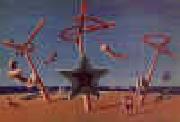 |
Edward Wadsworth
|
|
British
1889-1949
Edward Wadsworth Gallery
1949). English painter. He was raised in a northern industrial environment that was to appear with great forcefulness in his Vorticist work. He studied engineering in Munich from 1906 to 1907 and, like many other Vorticists (see VORTICISM), Wadsworth interest in the machine showed itself at an early age. He also studied art at the Knirr School in Munich in his spare time, before attending Bradford School of Art; he then studied through a scholarship at the Slade School of Art (1908-12) in London. Early paintings like Harrogate Corporation Brickworks (1908; untraced) show a growing interest in industrial subjects. Under the impact of the Post-Impressionists, he turned for a while to portraiture, beach scenes and still-lifes. His work was included in the final month of the Second Post-Impressionist Exhibition held at the Grafton Galleries in 1912, and in the summer of the same year he joined the Omega Workshops, although his alliance with Roger Fry was short-lived. Wadsworth new friendship with Wyndham Lewis led to an abrupt departure from Omega in October, when several of his works were included in Frank Rutter Post-Impressionist and Futurist exhibitions at the Doro Gallery in London. His painting L Omnibus (c. 1913; untraced; see 1974 exh. cat., no. 12) announced his involvement with motorized themes that clearly derived from Futurism. |
|
|
|
 |
Edward William Cooke
|
|
British Painter, 1811-1880
was an English painter and gardener. Cooke was born in London. His father George and uncle, William Bernard, were both well-known engravers and Cooke was raised in their wide artistic circle. He was a precocious draughtsman and a skilled engraver from an early age, displayed an equal preference for marine subjects and published his 'Shipping and Craft' C a series of accomplished engravings C when he was 18, in 1829. He benefited from the advice of many of his father's associates, notably Clarkson Stanfield (whose principal marine follower he became) and David Roberts. Cooke began painting in oils in 1833, took formal lessons from James Stark in 1834 and first exhibited at the Royal Academy and British Institution in 1835, by which time his style was essentially formed. He went on to travel and paint with great industry at home and abroad, indulging his love of the 17th-century Dutch marine artists with a visit to Holland in 1837. He returned regularly over the next 23 years, studying the effects of the coastal landscape and light, as well as the works of the country's Old Masters, resulting in highly successful paintings. These included 'Beaching a Pink at Scheveningen' (National Maritime Museum, London), which he exhibited in 1855 at the Royal Academy, of which he was an Associate from 1851. He went on to travel in Scandinavia, Spain, North Africa and, above all, to Venice.") Cooke was "particularly attracted by the Isle of Wight, and on his formative visit of 1835 he made a thorough study of its fishing boats and lobster pots; above all he delighted in the beaches strewn with rocks of various kinds, fishing tackle, breakwaters and small timber-propped jetties He also had serious natural history and geological interests, being a Fellow of the Linnean Society, Fellow of the Geological Society and Fellow of the Zoological Society, |
|
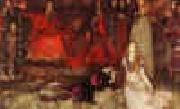 |
Edwin Austin Abbey
|
|
1852-1911
Edwin Austin Abbey Gallery
Edwin Austin Abbey (April 1, 1852 ?C August 1, 1911) was an American artist, illustrator, and painter. He flourished at the beginning of what is now referred to as the "golden age" of illustration, and is best known for his drawings and paintings of Shakespearean and Victorian subjects. His most famous work, The Quest of the Holy Grail, resides in the Boston Public Library.
Abbey was born in Philadelphia, Pennsylvania in 1852. He studied art at the Pennsylvania Academy of the Fine Arts under Christian Schuessele. Abbey began as an illustrator, producing numerous illustrations and sketches for such magazines as Harper's Weekly and Scribner's Magazine. His illustrations began appearing in Harper's Weekly at an early age: before Abbey was twenty years old. Abbey was an illustrator with Harper's Weekly from 1871-1874. He moved to England in 1878 where he was made a full member of the Royal Academy in 1898. In 1902 he was chosen to paint the coronation of King Edward VII. It was the official painting of the occasion and, hence, resides at Buckingham Palace. In 1907 he declined an offer of knighthood in order to retain his U.S. citizenship. Friendly with other expatriate American artists, he summered at Broadway, Worcestershire, England, where he painted and vacationed alongside John Singer Sargent at the home of Francis Davis Millet.
He completed murals for the Boston Public Library in the 1890s. The frieze for the Library was titled "The Quest for the Holy Grail." It took Abbey eleven years to complete this series of murals in his England studio. In 1908-1909, Abbey painted a number of murals and other artworks for the rotunda of the new Pennsylvania State Capitol in Harrisburg, Pennsylvania. His works in that building include allegorical medallions representing Science, Art, Justice, and Religion in the Capitol Rotunda, large lunette murals underneath the Capitol dome, and a number of works in the House Chamber. Unfortunately, Abbey became ill with cancer in 1911 slowing his work. At the time, he was working on the "Reading of the Declaration of Independence Mural" which was later installed in the House Chamber. Abbey was so ill, that his studio assistant, Ernest Board completed the work with little supervision from Abbey. Later in 1911, Abbey died, leaving his commission for the State Capitol of Pennsylvania unfinished. John Singer Sargent, a friend and neighbor of Abbey, and studio assistant Board completed the "Reading of the Declaration of Independence Mural." Abbey's works were installed in the Rotunda and House Chamber. Two rooms from Abbey's commission were left undone, and the remainder of the commission was given to Violet Oakley. Oakley completed the works from start to finish using her own designs.
Abbey was elected to the National Academy of Design and The American Academy of Arts and Letters. In 1937 Yale University became the home for a sizable collection of Abbey's works, the result of a bequest from Abbey's widow. |
|
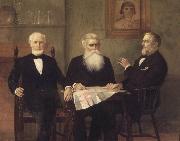 |
Edwin Blashfield
|
|
(December 5, 1848 - October 12, 1936), an American artist, was born in New York City.
He was a pupil of Leon Joseph Florentin Bonnat in Paris beginning in 1867, and became (1888) a member of the National Academy of Design in New York. For some years a genre painter, he later turned to decorative work, where his academic background in painting and extensive travels to study fresco painting in Italy melded in work marked by rare delicacy and beauty of coloring.
Considered a leading muralist of the late 19th century, he painted mural decorations or created mosaics in a number of places associated with the American Renaissance period.
His style is cited as an influence of Pierre Puvis de Chavannes, Jean-Paul Laurens, and Paul Baudr.
With his wife he wrote Italian Cities (1900) and edited Vasari's Lives of the Painters (1896), and was well known as a lecturer and writer on art. He became president of the Society of Mural Painters, and of the Society of American Artists.
|
|
|
|
|
|
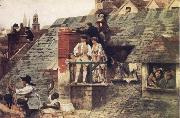 |
Edwin Howland Blashfield
|
|
mural painter and mosaic designer.
American ,1848-1936
American painter. He began to study art seriously in 1867 in Paris under L?on Bonnat, with whom he remained (except between 1870 and 1874) until 1880. Blashfield's mural style was significantly influenced by Pierre Puvis de Chavannes, Jean-Paul Laurens and Paul Baudry, whose decorations he had studied in the Panth?on while in Paris. He made a trip in 1887 to England, where he became briefly associated with the Anglo-American artists' colony in Broadway, Glos, which included Edwin Austin Abbey, John Singer Sargent, Lawrence Alma-Tadema and Frederic Leighton. |
|
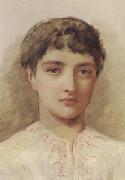 |
Edwin long,R.A.
|
|
1829-1891
.English painter. He was taught by John 'Spanish' Phillip and began his career painting portraits and Spanish subjects, such as Dialogus diversus (1873; priv. col., see Quick, p. 10). However, he became successful and rich with very large historical and biblical subjects such as the Babylonian Marriage Market (1875; Egham, U. London, Royal Holloway & Bedford New Coll.), which changed hands in his lifetime for immense sums. His choice of subject-matter was indebted to the example of Sir Lawrence Alma-Tadema, while his style closely resembles that of Edward Armitage. His success enabled him to commission two houses (1878 and 1887), both in Hampstead, from Richard Norman Shaw. He was elected ARA in 1876 and RA in 1881. |
|
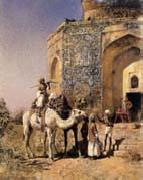 |
Edwin Lord Weeks
|
|
American Academic Painter, 1849-1903, American artist, was born at Boston, Massachusetts, in 1849. He was a pupil of Leon Bonnat and of Jean-Leon Gerome, at Paris. He made many voyages to the East, and was distinguished as a painter of oriental scenes. In 1895 he wrote and illustrated a book of travels, From the Black Sea through Persia and India, and two years later he published Episodes of Mountaineering. He died in November 1903. He was a member of the Legion d'honneur, France, an officer of the Order of St. Michael, Germany, and a member of the Secession, Munich. |
|
|
|
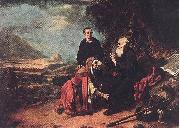 |
EECKHOUT, Gerbrand van den
|
|
Dutch Baroque Era Painter, 1621-1674
Dutch painter, draughtsman and etcher. He was the son of the goldsmith Jan Pietersz. van den Eeckhout and 'a great friend' as well as a pupil of Rembrandt, according to Houbraken, who commented that van den Eeckhout painted in the style of his master throughout his career. This is certainly true of van den Eeckhout's (biblical) history paintings, but less so of either his portraits, which gradually displayed more Flemish elegance, or his genre pieces (from 1650), in which he followed various trends; he adapted his style to suit his subject with sensitive versatility. He was also a gifted colourist and an artist of great imagination, superior in both these respects to such better-known Rembrandt pupils as Ferdinand Bol and Nicolaes Maes. Moreover, he was extremely productive, and there is at least one dated painting for virtually every year between 1641 and 1674. In addition, he created a large body of drawings comprising histories, figures, landscapes and genre scenes executed in various media, including watercolour. |
|
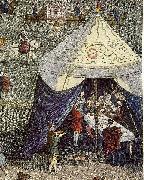 |
Eero Jarnefelt
|
|
(8 November 1863 - 15 November 1937) was a Finnish realist painter.
Eero Järnefelt was born in Viipuri, Finland. His father August Aleksander Järnefelt was an officer in the Russian army and his mother was Elisabeth Järnefelt. He studied at the St. Petersburg art academy between 1883 and 1885, the same school at which Albert Edelfelt had studied. Eero Järnefelt's sister Aino Järnefelt married composer Jean Sibelius in 1892,
Eero Järnefelt's sisters and brothers were Kasper, Arvid, Aino Ellida, Ellen, Armas, Hilja and Sigrid.
He went to study in Paris in 1886, where he became friends with Akseli Gallen-Kallela, Emil Wikström and Louis Sparre. He was inspired by the plein-air and naturalistic paintings of Jules Bastien-Lepage
On a trip to Keuruu in 1889, he met actress Saimi Swan. They were married in 1890.
His most famous painting is probably The Wage Slaves (Raatajat rahanalaiset or Kaski, from 1893, External link), depicting slash-and-burn agriculture. |
|
 |
EERTVELT, Andries van
|
|
Flemish painter (b. 1590, Antwerpen, d. 1652, ?)
Flemish painter. He enrolled as a member of Antwerp's Guild of St Luke in 1609. In 1615 he married Catherine Vlieger (d 1627), after whose death he went to Genoa, where he worked for Cornelis de Wael. By c. 1630 he was back in Antwerp, where he had his portrait painted by Anthony van Dyck (1632; Augsburg, Schaezlerpal.). In 1633 Eertvelt married Elisabeth Boots, probably a daughter of the Antwerp painter Jan Boots (b before 1620). Eertvelt is regarded as the first Flemish marine painter. Over the years his palette and style changed. His first paintings, mostly of ships in storms (e.g. Sea Battle in a Storm; Schwerin, Staatl. Mus.), were painted in greenish-black and brown tones, often using white to highlight the rigging against the dark sea. After his tour of Italy he favoured views of southern harbours, with calm seas painted in soft tones (e.g. Spanish Ships Leaving a Port; Vienna, Ksthist. Mus.). In his day Eertvelt was a man of distinction whose artistic qualities were praised by the poet Cornelis de Bie and whose marine paintings were appreciated abroad, some being exported as far as Seville and Lisbon. |
|
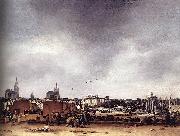 |
Egbert van der Poel
|
|
Egbert van der Poel (Delft, 1621 - Rotterdam, 1664) was a Dutch Golden Age genre and landscape painter, son of a Delft goldsmith.
He may possibly have been a student of Esaias van de Velde and of Aert van der Neer. According to the RKD he was the brother of the painter Adriaen Lievensz van der Poel and a student of Cornelis Saftleven in Rotterdam. Van der Poel was registered with the Guild of St Luke in Delft on October 17, 1650, where he is listed as a landscape painter. In 1651 van der Poel married Aeltgen Willems van Linschooten in Maassluis, near Rotterdam. His most famous paintings depict the Delft gunpowder explosion of October 12, 1654 and its aftermath; he and his wife were living in the area at the time. Egbert and Aeltgen van der Poel had a son and three daughters. He died in Rotterdam in 1664. |
|
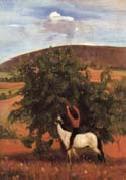 |
Egedius, Halfdan
|
|
1877-1899,Norwegian painter and illustrator. His artistic education began at the age of nine, when he enrolled at the school of art of Knud Bergslien (1827-1908) in Kristiania, where he was a pupil from 1886 to 1889. Even from this early period his painted studies and drawings, for instance of his sister Signe and brother Carl (both 1887; Oslo, N.G.), reveal striking maturity. In 1891 he was a pupil of Erik Werenskiold and from 1891 to 1892 he studied at the Arts and Crafts School in Kristiania. Egedius discovered his strongest impetus and greatest inspiration, however, on his first visit to Telemark in south-west Norway in summer 1892. The artist Torleif Stadskleiv (1865-1946), whom he met there and who became his closest friend, endeared the region to Egedius with stories of its traditions and people. In 1894 Egedius studied for a short period under Harriet Backer, and he made his d?but at the Kristiania Autumn Exhibition in 1894 with the painting Saturday Evening (Oslo, N.G.), painted in Telemark the previous year, which won high praise. In this landscape the atmosphere of the summer night is rendered with a lyrical use of colour and soft brushstrokes. Egedius spent the summer of 1894 in the inspiring and instructive company of a group of artists at V?g? in the Gudbrands Valley in north-west Norway, but for the summer of 1895 he was again in Telemark. Since his previous stay there he had matured artistically and his work now revealed a new confidence and boldness. The most notable paintings from 1895 are 'Juvrestolen' in Telemark, The Dreamer, Girls Dancing and the magnificent portrait of Mari Clasen (all Oslo, N.G.). He also began work on Music and Dance (Oslo, N.G., see fig.), which he continued the following year. |
|
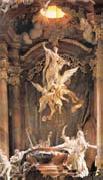 |
Egid Quirin Asam
|
|
German Baroque Era Sculptor, 1692-1750,was a German plasterer and sculptor active during the period of the Late Baroque. Born in Tegernsee, Bavaria, Asam worked mainly together with his brother, the architect and painter Cosmas Damian Asam. Because of this, their common work is often attributed to the Asam Brothers. Asam died in Mannheim. |
|
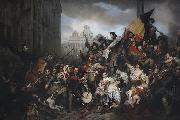 |
Egide Charles Gustave Wappers
|
|
(23 August 1803 Antwerp - 6 December 1874 Paris) is best known as the Belgian painter Gustave Wappers, while his oeuvre is also reckoned Flemish. He signed works by the name Gustaf Wappers.
He studied at the Royal Academy of Fine Arts in Antwerp, and during 1826 in Paris. The Romantic movement with its new ideas about art and politics was astir in France. Wappers was the first Belgian artist to take advantage of this state of affairs, and his first painting, "The Devotion of the Burgomaster of Leiden," appeared at the appropriate moment and had marvellous success in the Brussels Salon during 1830, the year of the Belgian Revolution. While political, this remarkable work revolutionized the direction of Flemish painters.
Episode of the Belgian Revolution of 1830 (1834), Museum of Ancient Art, Brussels.Wappers was invited to the court at Brussels, and was favoured with commissions. In 1832 the city of Antwerp appointed him Professor of Painting. He exhibited his masterpiece, "Episode of the Belgian Revolution of 1830" or rather "Episode of the September Days of 1830 on the Grand Place of Brussels", (Museum of Ancient Art, Brussels) at the Antwerp Salon in 1834. He was subsequently appointed painter to Leopold, King of the Belgians. At the death of Matthieu-Ignace Van Bree in 1839 he was elavated to director of the Antwerp Academy. One of his pupils was Ford Madox Brown; another was the Czech history painter Karel Javůrek.
His works are numerous; some of them in traditional devotional modes ("Christ Entombed"), while others illustrate the Romantic view of history: "Charles I taking leave of his Children", "Charles IX", "Camoens", "Peter the Great at Saardam", and "Boccaccio at the Court of Joanna of Naples".
Louis Philippe gave him a commission to paint a large painting for the gallery at Versailles, "The Defence of Rhodes by the Knights of St John of Jerusalem". He finished the work in 1844, the same year that he received the title of baron from Leopold I.After retiring as director of the Antwerp Academy, he settled in 1853 in Paris, where he died in 1873 - having been one of the most talented flagships of Romanticism in Belgium.
|
|
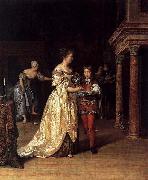 |
Eglon van der Neer
|
|
(1635/36, - May 3, 1703), was a Dutch painter of historical scenes, portraits and elegant, fashionable people, and later of landscapes.
Van der Neer was born in Amsterdam and was probably first taught by his father, Aert van der Neer, who married in Amsterdam in 1629, coming from Gorinchem. Eglon had a least five brothers and sisters, who were baptized in the Nieuwe Kerk between 1640 and 1650. He took lessons from Jacob van Loo, who was then one of the foremost figure painters in Amsterdam. Around 1654 Van der Neer, who probably had just finished his education with Van Loo, traveled to Orange, Vaucluse in the South of France and entered the service of Friedrich von Dohna (1621-1688), Governor of the Principality of Orange. Van der Neer stayed for three or four years in Orange and returned to Amsterdam by the end of 1658. There he married in February Maria Wagensvelt, the daughter of a wealthy Rotterdam notary. In 1663 Van der Neer and his family moved to Rotterdam, where Adriaen van der Werff became his student. He stayed in Rotterdam until his wife died in 1677. In 1679 he moved to The Hague and in 1680 he became a member of the Confrerie Pictura there. Later that year he moved again, taking up his residence at Brussels, where he married the miniature painter Marie Du Chastel in the following year. She bore him nine children.
|
|
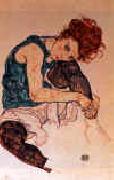 |
Egon Schiele
|
|
1890-1918
Austrian
Egon Schiele Gallery
Egon Schiele (12 June 1890 ?C 31 October 1918) was an Austrian painter, a protege of Gustav Klimt, and a major figurative painter of the early 20th century. Schiele's body of work is noted for the intensity and the large number of self-portraits he produced. The twisted body shapes and the expressive line that characterize Schiele's paintings and drawings make the artist an early exponent of Expressionism, although still strongly associated with the art nouveau movement (Jugendstil). The most important collection of Schiele's work is housed in the Leopold Museum, Vienna.
In 1907, Schiele sought out Gustav Klimt. Klimt generously mentored younger artists, and he took a particular interest in the gifted young Schiele, buying his drawings, offering to exchange them for some of his own, arranging models for him and introducing him to potential patrons. He also introduced Schiele to the Wiener Werkstätte, the arts and crafts workshop connected with the Secession. In 1908 Schiele had his first exhibition, in Klosterneuburg. Schiele left the Academy in 1909, after completing his third year, and founded the Neukunstgruppe ("New Art Group") with other dissatisfied students.
Sitzender weiblicher Akt, 1914Klimt invited Schiele to exhibit some of his work at the 1909 Vienna Kunstschau, where he encountered the work of Edvard Munch, Jan Toorop, and Vincent van Gogh among others. Once free of the constraints of the Academy's conventions, Schiele began to explore not only the human form, but also human sexuality. At the time, many found the explicitness of his works disturbing. |
|
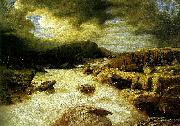 |
egron lundgren
|
|
Egron Sellif Lundgren, född 18 december 1815 i Stockholm, död 16 december 1875 i Stockholm var en svensk konstnär och författare. Hans lite egendomliga förnamn är givet av en omtänksam fader som önskade sin lille nyfödde ett rofyllt liv, eg-ron.
Egron Lundgren kan betecknas som den svenska akvarellkonstens fader. Han började först som oljemålare där han utförde genremålningar och historiska framställningar i tidens anda. Under sina många resor till Italien, Spanien och Indien fann han dock sitt rätta uttrycksmedel i akvarellen vars teknik han utvecklade till ett mästerskap. Han bosatte sig i mitten av 1850-talet i London där han hade stora framgångar som porträttmålare.
Med London som utgångspunkt företog han sedan ytterligare resor både till Italien och Spanien men även till Egypten och Indien. Hans reportagemålningar från sepoyupproret i Indien anses utgöra en av höjdpunkterna i hans produktion.
Hans akvarellteknik utvecklades med åren till en snabb, upplöst teknik i rena, klara färger och lätt penselföring.
England med sina dimhöljda öar kom till fullt uttryck i arbetena från hans många resor.
Sina sista år tillbringade Egron Lundgren i Stockholm men också därifrån fortsatte han sitt resande. Mest känd för en sentida publik har han blivit genom sina brev och dagboksanteckningar, utgivna under titeln En målares anteckningar 1 - 2
Egron Lundgrens väg i Södra Ängby, Stockholm är uppkallad efter Egron Lundgren. |
|
|
|
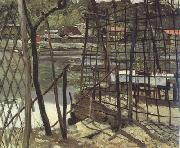 |
Eilif Peterssen
|
|
1852-1928
was a Norwegian painter. He attended the of Fredrik Eckersberg in Kristiania (now Oslo) in 1866 and 1870. After that, he studied painting briefly with Knud Bergslien at the Johan Fredrick Eckersberg School of Painting and left to go abroad in 1871. He studied at the School of Art of Copenhagen; in Karlsruhe (1871?C1873), where he was a student of Hans Gude; and, together with Hans Heyerdahl, in Munich under Wilhelm von Diez. He then studied in London, Paris, and Italy. After these travels, he returned to Norway and settled in Bærum. He made his debut at the Høstutstillingen (Autumn Exposition) in Kristiania in 1882. He was a profound connoisseur of European art and was later associated groups such as Lysaker, the painters of Fleskum and those of Skagenpainters, as well as with individual artists like August Eiebakke, Kitty Kielland and Harald Oskar Sohlberg. In Norway, he is also known as the designer of the coat of arms of Norway, adopted when the country separated from Sweden in 1905 to become an independent country. This version was used for official government purposes until 1937, when it was replaced by a new version. Nonetheless, Peterssen's design is still used for the royal coat of arms and for the royal flag. In addition to his canvasses, he collaborated on the decoration of the Tourist Hotel in Holmenkollen in 1889. In the same year, he painted the murals "The Wanderers of Emmaus" in the Church of Tanum in Bærum and "Jesus in the Garden of Gethsemane" in the Church of the Cross, Bergen. |
|
|
|
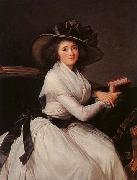 |
eisabeth Vige-Lebrun
|
|
(Marie Élisabeth Louise; 16 April 1755 - 30 March 1842) was a French painter, and is recognized as the most famous female painter of the 18th century. Her style is generally considered Rococo and shows interest in the subject of neoclassical painting. Vigee Le Brun cannot be considered a pure Neoclassist, however, in that she creates mostly portraits in Neoclassical dress rather than the History painting. In her choice of color and style while serving as the portrait painter to Marie Antoinette, Vigee |
|
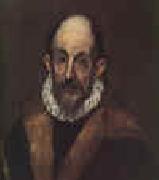 |
El Greco
|
|
Greek-born Spanish Mannerist Painter, 1541-1614
Considered a representative of late Renaissance Spanish art, El Greco was actually born in Greece, on the island of Crete. After studying in Venice under Titian, El Greco settled in Toledo, Spain in 1577. At the time he was wildly popular, his emotionally religious paintings being just the ticket for the hometown of the Spanish Inquisition. After his death his work was largely ignored until the beginning of the 20th century; now he considered one of the inspired geniuses of Western art. His distinctive style features bold shapes and colors, with elongated and slightly distorted figures.
In Toledo El Greco was in constant demand and liked living large: he maintained a private orchestra to accompany his meals. |
|
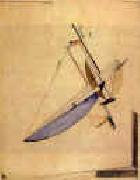 |
El Lissitzky
|
|
Russian
1890-1941
He was an important figure of the Russian avant garde, helping develop suprematism with his mentor, Kazimir Malevich, and designing numerous exhibition displays and propaganda works for the former Soviet Union. His work greatly influenced the Bauhaus and constructivist movements, and he experimented with production techniques and stylistic devices that would go on to dominate 20th century graphic design.
El Lissitzky's entire career was laced with the belief that the artist could be an agent for change, later summarized with his edict, "das zielbewußte Schaffen" (goal-oriented creation). A Jew, he began his career illustrating Yiddish children's books in an effort to promote Jewish culture in Russia, a country that was undergoing massive change at the time and that had just repealed its anti-semitic laws. When only 15 he started teaching; a duty he would stay with for most of his life. Over the years, he taught in a variety of positions, schools, and artistic media, spreading and exchanging ideas. He took this ethic with him when he worked with Malevich in heading the suprematist art group UNOVIS, when he developed a variant suprematist series of his own, Proun, and further still in 1921, when he took up a job as the Russian cultural ambassador to Weimar Germany, working with and influencing important figures of the Bauhaus and De Stijl movements during his stay. In his remaining years he brought significant innovation and change to typography, exhibition design, photomontage, and book design, producing critically respected works and winning international acclaim for his exhibition design. This continued until his deathbed, where in 1941 he produced one of his last works ?? a Soviet propaganda poster rallying the people to construct more tanks for the fight against Nazi Germany. |
|
|
|
|
|
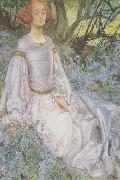 |
Eleanor Fortescue-Brickdale,RWS
|
|
1872-1945
English illustrator, painter and designer. She entered the Royal Academy Schools, London, and won a prize for a mural design in 1897. She specialized in book illustration, in pen and ink and later in colour. Among her many commissions were illustrations to Tennyson's Poems (1905) and Idylls of the King (1911) and Browning's Pippa Passes (1908). She was particularly popular with the publishers of the lavishly illustrated gift-books fashionable in the Edwardian era. She exhibited regularly at the Royal Academy and the Royal Water-Colour Society. She took up stained-glass design (windows in Bristol Cathedral), which modified her style of illustration to flat areas of colour within black outlines. |
|
|
|
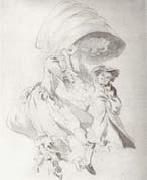 |
Elias Martin
|
|
Swedish Painter, 1739-1818,Painter and engraver. After training in his father joinery shop and with the painter Friedrich Schultz (1709-69), he was engaged to design ornamentation for ships of the coastal fleet at Sveaborg (Finland). There he also taught drawing to the son of Field Marshal Count Augustin Ehrensv?rd (1710-72) while himself learning printmaking techniques from the Field Marshal. During this period Martin produced accurate studies of Finland coastal scenery and the Sveaborg fortress (e.g. Stockholm, Nmus.), as well as purely imaginary landscapes based on engravings. In 1766 he went to Paris and with Alexander Roslin help was able to study under Joseph Vernet at the Acad?mie Royale de Peinture et de Sculpture. A direct result of his studies was a View of Paris from the Quay Beneath the Pont Neuf (1766-7; Stockholm, Nmus.). |
|
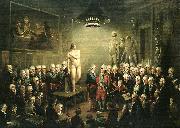 |
elias martin, gustav
|
|
Elias Martin, döpt 8 mars 1739 i Stockholm, död 25 januari 1818, svensk målare som vann internationell berömmelse under sin livstid för sina landskapsmålningar, porträtt och genremålningar, och var "associate member" av Royal Academy.
Elias Martin var son till åldermannen i snickarämbetet Olof Martin och Ulrika Haupt, syster till Georg Haupt. Han fick sin första utbildning hos fadern och visade sådan talang att han sändes till ämbetsmålaren F.C. Schultz. Genom denne fick han anställning hos Fredrik Henrik af Chapman som arkitekturritare och teckningslärare för officerarna i Sveaborg. Där fick han ledning av fältmarskalken Augustin Ehrensvärd, och umgick med och undervisade dennes son Carl August Ehrensvärd. |
|
|
|
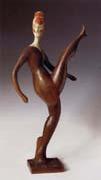 |
Elie Nadelman
|
|
Polish-born American Abstract Sculptor, 1882-1946,was an American sculptor, draughtsman and collector of Polish birth. Nadelman studied briefly in Warsaw and then visited Munich in 1902 where he became interested in Classical antiquities at the Glytothek. He lived in Paris from 1904 to 1914, closely involved with the avant-guarde, exhibiting at the Societe des Artistes Independants and at the Salon d'Automne from 1905 to 1908. His first solo exhibition in 1909 at the Galerie Druet, Paris, revealed a large series of plaster and bronze classical female heads and full-length standing nudes and mannered Cubist drawings; the latter purchased by Leo Stein, who had brought Picasso to Nadelman's studio in 1908. For the most detailed and accurate studies of Nadelman's work from 1905-12, which was of crucial importance for early 20th c. modern sculpture, see Athena T. Spear in Bibliography. He moved to the United States (becoming an American citizen in 1927) during the outbreak of World War I, married Mrs. Viola Flannery, a wealthy heiress,and assembled a large, museum quality collection of folk sculpture. |
|
|
|
 |
Elihu Vedder
|
|
American Symbolist Painter, 1836-1923
American painter, illustrator, sculptor and writer. He studied under Tompkins Harrison Matteson in Shelbourne, NY, and went to Paris in March 1856. After eight months in the studio of Fran?ois-Edouard Picot, he settled in Florence until the end of 1860. There he learnt drawing from Raffaello Bonaiuti, became interested in the Florentine Renaissance and attended the free Accademia Galli. A more significant artistic inspiration came from the Italian artists at the Caff? Michelangiolo: Telemaco Signorini, Vincenzo Cabianca (1827-1902) and especially Nino Costa (1827-1902). This group sought new and untraditional pictorial solutions for their compositions and plein-air landscapes and were particularly interested in the experiences of Gustave Courbet and the Barbizon painters. They became known as Macchiaioli for their use of splashes (macchia) of light and shadows and for their revolutionary (maquis) attitude to prevailing styles. Among Vedder's most notable Florentine landscapes are Mugnone Torrent near Fiesole (Detroit, MI, Inst. A.) and Le Balze, Volterra (Washington, DC, N. Mus. Amer. A.) |
|
|
|
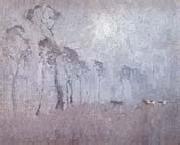 |
Elioth Gruner
|
|
New Zealand-born Australian Painter, 1882-1939,Australian painter. The son of a Norwegian father and Irish mother, he came to Sydney from New Zealand with his family in 1883. He received his first art lessons from Julian Rossi Ashton, although for many years he had little time for painting, instead working to support his family. He finally achieved recognition as an artist around the beginning of World War I. Following successful sales he became a full-time painter, championed in Sydney as the exemplary heir to the impressionist pastoral tradition of Australian art, which had been established in the late 19th century. Between 1915 and 1920, under the influence of Max Meldrum, he focused on the landscape as seen against the light. Painting en plein air he specialized in effects of early morning, for example Morning Light (1916; Sydney, A.G. NSW), one of a series painted at Emu Plains (1915-19), |
|
|
|
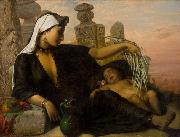 |
Elisabeth Jerichau Baumann
|
|
(born November 21, 1819 - died July 11, 1881 in Copenhagen) was a Polish-born Danish painter. She was married to the sculptor Jens Adolf Jerichau.
Elisabeth Jerichau-Baumann was born in Zoliborz (Jolibord) a borough of Warsaw.Her father Philip Adolph Baumann (1776 - 1863), a mapmaker, and her mother, Johanne Frederikke Reyer (1790 - 1854), were German.
At the age of nineteen, she began her studies in Desseldorf which at the time was one of the most important art centres in Europe and her early subject matter was drawn from Slovak life. She began exhibiting there and in 1844 attracted public attention for the first time. After she moved to Rome, her paintings were primarily of local life. It was here that she met her future husband, Jens Adolf Jerichau, whom she married in 1846. When the artist couple was not travelling, she spent many hours a day in their studio in Rome. She was particularly fond of the Italian carnival as a theme.
|
|
|
|
|

